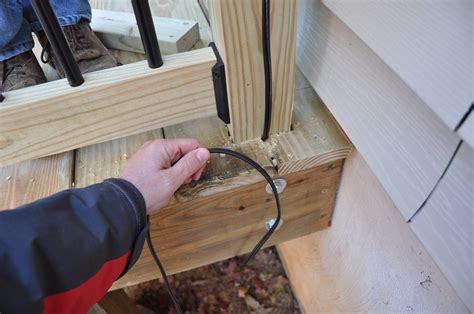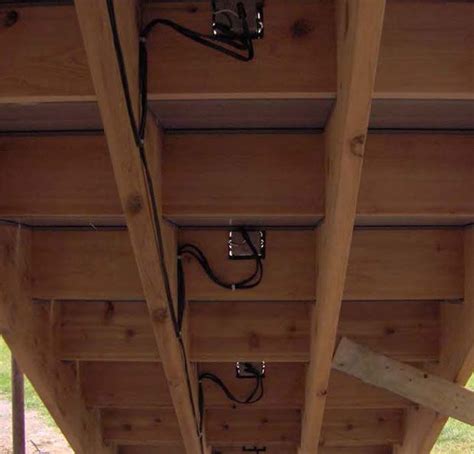conduit junction box under deck Buried wiring runs that transition from underground to above ground must be protected in conduit from the required cover depth or 18 inches (whichever is less) to its termination point above ground, or at least 8 feet . Shop Wayfair for the best adjustable vanity light electric junction box. Enjoy Free Shipping on most stuff, even big stuff.
0 · wiring under deck
1 · under deck electrical wiring instructions
2 · under deck conduit installation
3 · running electrical cable under deck
4 · outdoor conduit under deck
5 · electrical conduit under deck
6 · conduit under deck requirements
7 · conduit under deck codes
Vance Metal has completed the Certification process for the ASME U and R Pressure .

You will need to run a ground wire with plastic conduit. I recommend you run a ground wire with metal conduit - in the great outdoors, that stuff will rust, even if it's galvanized, . Additionally, the conduit must connect to an approved junction box at its entry or exit from the adjacent structure's walls. Most conduit connects to . The customer has requested conduit runs to be located in the deck framing, so as to minimize the amount of conduit that is visible. In that case conduit would run underneath the . Buried wiring runs that transition from underground to above ground must be protected in conduit from the required cover depth or 18 inches (whichever is less) to its termination point above ground, or at least 8 feet .
Conduit travels under Deck and splits (picture 3) onward to receptacles. I was think of putting another junction at picture 2 point and use that to transition from new 12/2 UF (from .

If I go with Option 1, I have to drill a hole in the deck (which is fine) to run under it. But how do I "protrude" the box at first? Do I replace the existing box so it's staying outside the wall? You don't have to have a box where it goes through, unless you're doing a junction, switching from indoor wire to outdoor or something like that. Just run the wire through the .
The best way to run electrical wire under outdoor decks is to do it in a conduit and use an exterior-grade wire and box as the code requires. Furthermore, it is important that if the wiring is above-ground, it should be high enough that animals can’t nibble on it.This step involves installing conduit (if using) along the planned route and securing it in place with fasteners, connecting electrical wires to junction boxes at both ends of the route, pulling wires through a conduit (if using), securely attaching junction box covers, and finally applying a waterproof sealant over exposed wiring. You will need to run a ground wire with plastic conduit. I recommend you run a ground wire with metal conduit - in the great outdoors, that stuff will rust, even if it's galvanized, which will eventually cause grounding problems. If you have metal (commonly aluminum) boxes in your system, there will be a hole already tapped 10-32 for a ground . Additionally, the conduit must connect to an approved junction box at its entry or exit from the adjacent structure's walls. Most conduit connects to a specialized outdoor electrical box called an LB fitting.
wiring under deck
The customer has requested conduit runs to be located in the deck framing, so as to minimize the amount of conduit that is visible. In that case conduit would run underneath the deck boards, and only penetrate the decking to reach outlets. Buried wiring runs that transition from underground to above ground must be protected in conduit from the required cover depth or 18 inches (whichever is less) to its termination point above ground, or at least 8 feet above grade. Conduit travels under Deck and splits (picture 3) onward to receptacles. I was think of putting another junction at picture 2 point and use that to transition from new 12/2 UF (from receptacle inpicture 1) to 12/3 THHN when uses the conduit.
1) Run 12/2 romex from the panel to a junction box near the exterior wall, transition to 12/2 UF-B wire, run the UF-B into a piece of PVC conduit that goes through the wall into a LB fitting on the outside of the house, and then attach the UF-B to the underside of my deck joists and connect the 2 or 3 outdoor outlets? If I go with Option 1, I have to drill a hole in the deck (which is fine) to run under it. But how do I "protrude" the box at first? Do I replace the existing box so it's staying outside the wall? I have a roll of Liquid Tight Non Metallic Conduit to run the power through, to a water-rated outdoor 1-gang electrical box fitted with a tamper-resistant weather-resistant GFCI outlet. I plan on running the conduit under the deck to . The best way to run electrical wire under outdoor decks is to do it in a conduit and use an exterior-grade wire and box as the code requires. Furthermore, it is important that if the wiring is above-ground, it should be high enough that animals can’t nibble on it.
This step involves installing conduit (if using) along the planned route and securing it in place with fasteners, connecting electrical wires to junction boxes at both ends of the route, pulling wires through a conduit (if using), securely attaching junction box covers, and finally applying a waterproof sealant over exposed wiring.
You will need to run a ground wire with plastic conduit. I recommend you run a ground wire with metal conduit - in the great outdoors, that stuff will rust, even if it's galvanized, which will eventually cause grounding problems. If you have metal (commonly aluminum) boxes in your system, there will be a hole already tapped 10-32 for a ground .
Additionally, the conduit must connect to an approved junction box at its entry or exit from the adjacent structure's walls. Most conduit connects to a specialized outdoor electrical box called an LB fitting. The customer has requested conduit runs to be located in the deck framing, so as to minimize the amount of conduit that is visible. In that case conduit would run underneath the deck boards, and only penetrate the decking to reach outlets.
international sheet metal review magazine
Buried wiring runs that transition from underground to above ground must be protected in conduit from the required cover depth or 18 inches (whichever is less) to its termination point above ground, or at least 8 feet above grade. Conduit travels under Deck and splits (picture 3) onward to receptacles. I was think of putting another junction at picture 2 point and use that to transition from new 12/2 UF (from receptacle inpicture 1) to 12/3 THHN when uses the conduit. 1) Run 12/2 romex from the panel to a junction box near the exterior wall, transition to 12/2 UF-B wire, run the UF-B into a piece of PVC conduit that goes through the wall into a LB fitting on the outside of the house, and then attach the UF-B to the underside of my deck joists and connect the 2 or 3 outdoor outlets?
inventor convert to sheet metal
If I go with Option 1, I have to drill a hole in the deck (which is fine) to run under it. But how do I "protrude" the box at first? Do I replace the existing box so it's staying outside the wall?
under deck electrical wiring instructions
under deck conduit installation
These PDUs, also known as junction or fuse boxes, are ideal solutions for battery electric vehicle (BEV) applications. The power distribution unit (PDU) delivers power to all critical traction and auxiliary loads, while protecting electronic components and vehicle occupants.
conduit junction box under deck|wiring under deck